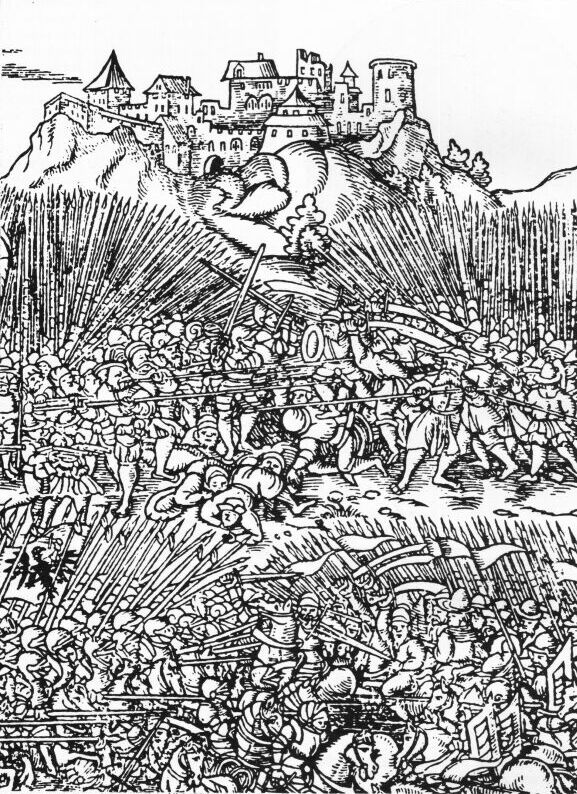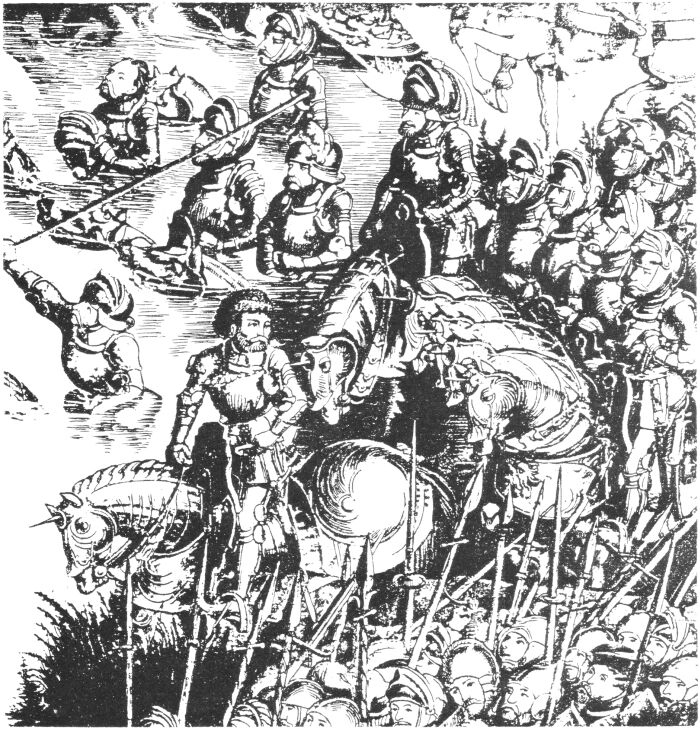 Grunwald Battle, July 15, 1410
Grunwald Battle, July 15, 1410Great Battles in the History of Belarusian Nation
Battle at Voksla-river, 1399
Great Prince of the Grand Duche of Lithuania Vitaut the Great had stopped the European invasion of Timur (Tamerlan) from Asia heading a big Army of Belarusians, Lithuanians and knights from all of Christian Europe in 1399 in the battle at Vorskla-river (in modern Ukraine).
 Grunwald Battle, July 15, 1410
Grunwald Battle, July 15, 1410
Vitaut the Great together with Polish King Yahajla (his brother) led the united army of 100, 000 warriors, which included representatives of all the East European peoples, to the victory in the famous Battle of Grunwald. The battle which took place on July, 15, 1410, near Grunwald (Prussia at the time, now in Northern Poland) was hard and severe and the crusaders were utterly defeated by the united troops. After this battle, the Great Lithuanian Principality - Belarusian atate at the time - expanded its borders to the Baltic Sea and became the most powerful state in Eastern Europe.
<--- Left: "Grunwald Battle" - Fragment of a print "Chronicles of Entire World" by M. Bel'ski
 Battle of Vorsha, September 8, 1514
Battle of Vorsha, September 8, 1514
Fortunately by his victory over the Russians at Vorsha in 1514, the Hetman of the Grand Duchy, Prince Constantine Astrozhski, saved the Minsk from further immediate misfortune. Prior to the battle, the Grand Duke Zyhimunt II {Pol. I.) and the whole Court came from Vilnia to Minsk to direct the campaign, in which the Namiesnik (sheriff) of the city. Prince Bahdan Zaslauski also took part. The Joint 80,000 Army of Muscovy Tsar Basil III has met with 25,000 army of Hetman Kanstancin Astrozhski, which consisted of light cavalry and some infantry. Only the military genius of Astrozhski has let him to defeat Muscovy army that was 3X larger than his. Astrozhski has sent light cavalry to meet with Russians, then commanded to retreat towards the nearest forest. Russians has rushed into chasing retreating Belarusians. Then Astrozhski commanded the cavalry to split to left and right and Muscovites have run into artillery of Belarusians hidden in the forest. This created a havoc and Russians started to retreat towards the rivers of Dnieper and Krapiwna. For 5 miles Astrozhski cavalry was chasing retreating Russians and killing them until the dawn has came down. 40,000 Muscovites had several thousands were captured prisoners. The Battle of Vorsha was one of the targets in XVI c Europe. It has for years stopped Russians from returning to the Grand Duchy of Lithuania. To commemorate this victory two cathedrals - of St. Trinity and of St. Nicholas were built in Vilna (Vilnius) - the capital of the Grand Duchy of Lithuania at that time.
Every year Belarusians mark anniversary of the Battle at Vorsha by the minstrel festival at the place of the battle near Krapiwna and Dnieper rivers.
Siege of Smalensk, 1632
Muscovy tsars have sent a 40,000 Army to the Grand Duche of Lithuania. They have sieged Smaliensk and proceeded further taking towns like Polacak, Druja, Asveja. But citizen of Smaliensk were still defending their city against Russians. Polish King Uladzislau had sent out 25,000-strong Army to help them. Muscovites were surrounded and taking prisoners. The victorious Polish-Lithuanian Army has taken their cannonns and arms and let them free. Muscovy Tsar was so mad that he executed his Army commander himself.
Slucak Military Uprising, November 27, 1920
Military action against Bolshevicks begins in the Slucak region on November 27, 1920. The uprising is suppressed by December 28, 1920.
The Siege of the Fortress of Brest, 1941

Back to Belarusian Castles and Knighthood page
Links:
![]() A
Military History of Belarusian Lands Up to the End of Twelfth
Century By Jahor
Novikaǔ
A
Military History of Belarusian Lands Up to the End of Twelfth
Century By Jahor
Novikaǔ
This page is a part of the Virtual
Guide to Belarus - a collaborative project of Belarusian
scientists abroad. VG brings you the most extensive compillation of the information
about Belarus on the Web.
Please send your comments to the authors of VG to
Belarus
History | Statehood | Culture | Law and Politics | Cities | Nature and Geography
|